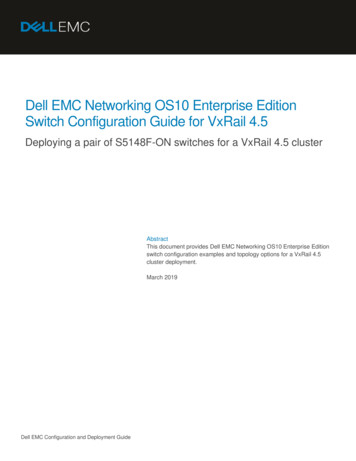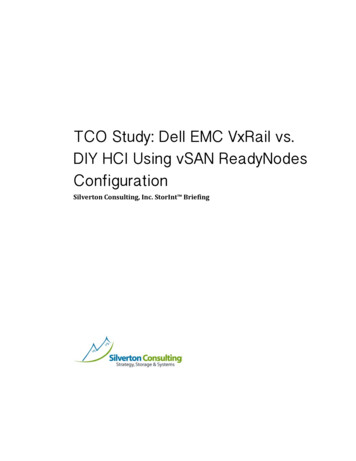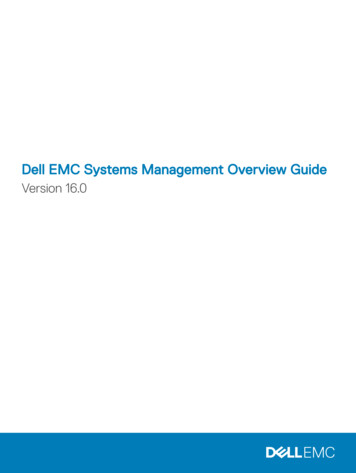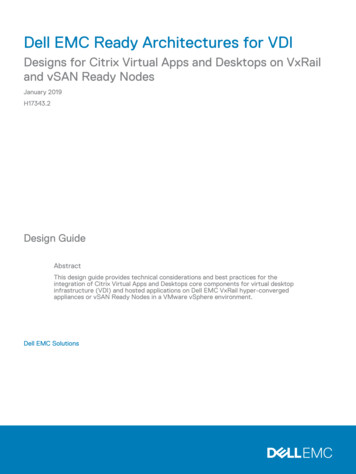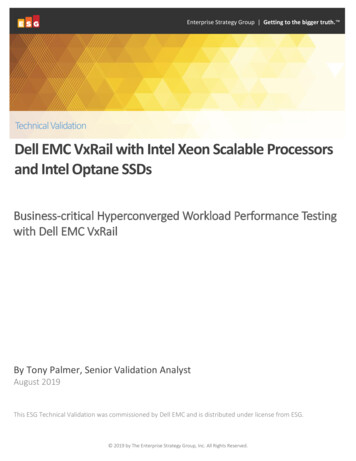
Transcription
Enterprise Strategy Group Getting to the bigger truth. Technical ValidationDell EMC VxRail with Intel Xeon Scalable Processorsand Intel Optane SSDsBusiness-critical Hyperconverged Workload Performance Testingwith Dell EMC VxRailBy Tony Palmer, Senior Validation AnalystAugust 2019This ESG Technical Validation was commissioned by Dell EMC and is distributed under license from ESG. 2019 by The Enterprise Strategy Group, Inc. All Rights Reserved.
Technical Validation: Dell EMC VxRail with Intel Xeon Scalable Processors and Intel Optane SSDs2ContentsIntroduction . 3Background . 3Dell EMC VxRail Hyperconverged Infrastructure . 4Second Generation Intel Xeon Processors and Intel Optane SSDs . 5Intel Optane DC SSDs . 5Second Generation Intel Xeon Processors . 5ESG Technical Validation . 5Business-critical Workload Performance . 6ESG Testing. 6What the Numbers Mean . 8The Bigger Truth. 9Appendix . 10ESG Technical ValidationsThe goal of ESG Technical Validations is to educate IT professionals about informationtechnology solutions for companies of all types and sizes. ESG Technical Validations are not meant to replacethe evaluation process that should be conducted before making purchasing decisions, but rather to provideinsight into these emerging technologies. Our objectives are to explore some of the more valuablefeatures and functions of IT solutions, show how they can be used to solve real customer problems, andidentify any areas needing improvement. The ESG Validation Team’s expert third-party perspective is basedon our own hands-on testing as well as on interviews with customers who use these products in productionenvironments. 2019 by The Enterprise Strategy Group, Inc. All Rights Reserved.
Technical Validation: Dell EMC VxRail with Intel Xeon Scalable Processors and Intel Optane SSDs3IntroductionThis report documents an ESG technical audit and validation of Dell EMC VxRail hyperconverged infrastructure (HCI)performance testing, which focused on comparisons of Dell EMC VxRail all-flash configurations with SAS SSD cache driveswith Dell EMC VxRail all-flash configurations with Intel Optane SSD Cache drives servicing business-critical workloads.BackgroundOrganizations today must be extremely agile and flexible in adding applications and virtual machines (VMs) and deploybusiness-critical production environments quickly to respond to the needs of the business. As a result, the popularity ofhyperconverged infrastructure (HCI) systems has increased considerably. HCI offers a single, centrally managed solutionwith software-defined compute, network, and storage that is flexible, scalable, and easy to deploy. Adoption of HCI hasgrown significantly since coming to market, and ESG research continues to confirm the popularity of HCI: In an ESGresearch study, 57% of respondents reported that they use or plan to use HCI solutions. This is not surprising, given thefactors driving them to consider HCI. Deployment drivers most cited by respondents include improved scalability (31%),total cost of ownership (28%), ease of deployment (26%), and simplified systems management (24%).1Figure 1. Hyperconverged Infrastructure Usage TrendsPlease indicate your organization’s usage of hyperconverged infrastructuretechnology solutions. (Percent of respondents, N 537)We have no plans foror interest inhyperconvergedinfrastructuretechnology at thistime, 43%We currently usehyperconvergedinfrastructuretechnology, 39%We have plans for or interest inhyperconverged infrastructuretechnology, 18%Source: Enterprise Strategy GroupIn ESG’s annual technology spending intentions survey, 37% of organizations said that they would make the mostsignificant investments deploying hyperconverged and/or converged infrastructure platforms in support of data centermodernization, and 55% of organizations indicated that spending on hyperconverged and converged technology wouldincrease in 2019.2Organizations are told to digitally transform, to become more agile, and to respond to the business faster in order tosurvive in a highly competitive market. One method used by organizations to digitally transform is modernizing theirinfrastructures, which means shifting from a traditional three-tier architecture to a solution that integrates compute,storage, networking, and virtualization. Such a solution must deliver a more cloud-like experience on-premises, making theeventual transition to the cloud easier while enabling organizations to confidently move cloud-native applications from the12Source: ESG Master Survey Results, Converged and Hyperconverged Infrastructure Trends, October 2017.Source: ESG Master Survey Results, 2019 Technology Spending Intentions Survey, March 2019. 2019 by The Enterprise Strategy Group, Inc. All Rights Reserved.
Technical Validation: Dell EMC VxRail with Intel Xeon Scalable Processors and Intel Optane SSDs4public cloud back to an on-premises private cloud. According to ESG research, adopters of HCI appreciate the simplicity ofdeploying and managing a tightly integrated infrastructure anchored in software-defined constructs. Early adoptersspecifically were keen on leveraging initial deployments to handle what were deemed tier-2 workloads (VDI or email, forexample).3 Organizations looking to move mission-critical workloads traditionally reserved for three-tiered architectures orconverged infrastructure (CI) solutions to HCI need to carefully consider the solution they choose. An HCI platformdeployed to support tier-1 workloads must provide high IOPS and low read/write latency, and do so in a consistent,predictable manner. Predictable performance is critical to maximize end-user productivity across an organization. Finally,the entry-level cost, buying a two- or three-node system, is far more appealing to organizations that are looking to startsmall and grow over time.Dell EMC VxRail Hyperconverged InfrastructureHCI platforms are solutions that deliver compute, software-defined storage, and networking infrastructure services in acluster of industry-standard servers. VxRail, powered by Dell EMC PowerEdge server platforms, is a turnkey HCI platformthat consolidates compute, storage, and virtualization—including Intel Optane SSD NVMe caching drives, SmartFabricservices when deployed with the Dell EMC PowerSwitch family, integration across the VMware ecosystem includingVMware VSAN, VMware hybrid cloud integration, and automated tools and guides designed to simplify deployment of asecure VxRail infrastructure.Figure 2. Dell EMC VxRail E, G, and P Series Hyperconverged InfrastructureSource: Enterprise Strategy GroupDell EMC, Intel, and VMware work together to quickly bring next-generation technologies to VxRail. Jointly developed withVMware, VxRail leverages proprietary VxRail HCI System Software to automate deployment and deliver complete lifecyclemanagement, speeding time to value in the core data center, in the cloud, and at the edge. Second Generation Intel XeonScalable processors and Intel Optane SSDs provide the compute and storage performance to service latency-sensitivebusiness-critical workloads including Oracle, SQL Server, and SAP HANA.3Source: ESG Master Survey Results, Converged and Hyperconverged Infrastructure Trends, October 2017. 2019 by The Enterprise Strategy Group, Inc. All Rights Reserved.
Technical Validation: Dell EMC VxRail with Intel Xeon Scalable Processors and Intel Optane SSDs5Second Generation Intel Xeon Processors and Intel Optane SSDsIntel Optane DC SSDsEliminating storage bottlenecks requires solutions that are fast, flexible, and non-volatile. The low latency and highperformance Intel Optane SSDs help reduce or eliminate data center storage bottlenecks and allow larger, moreeconomical data sets. Intel Optane technology is not NAND. Built on an architecture that allows memory cells to beindividually addressed in a dense, transistor-less, stackable design, Intel Optane SSDs can accelerate applications, reducetransaction costs for latency-sensitive workloads, and improve overall data center TCO.Benefits of Intel Optane SSDs include: High throughput and performance for business-critical workloads. Predictably fast servicing of I/O—Lower and more consistent response time than traditional NAND flash. This makesIntel Optane SSD better suited for critical applications with demanding latency requirements. Consistent performance scaling—Intel Optane SSD with its bit-level architecture enables consistent performance overlonger durations. High endurance—Intel Optane SSDs total drive writes per day is many times greater than NAND flash, which givesIntel Optane SSDs a much longer useful life than traditional NAND. Economics—A smaller Intel Optane SSD cache can provide comparable performance gains to a much larger NANDflash device. ESG testing in this report used Intel Optane SSD cache with less than half the capacity of the NAND cachewe were comparing.Second Generation Intel Xeon ProcessorsIntel’s latest processor is the second generation processor built on thePurley platform, and provides multiple performance enhancementsincluding: Intel Speed Select Technology—Configurable core and/orfrequency processor attributes, prioritization of workloadperformance, and support for platform TCO optimizations. Intel Security Libraries—New Intel Threat Detection Technology,Intel Trusted Execution Technology, and Intel Cloud IntegrityTechnology support a secure platform at the hardware level.Hardware Mitigation of Side ChannelVulnerabilitiesL1TF vulnerability is a side-channel attack based onthe information about how a system is implemented,where a malicious VM may infer contents of thehypervisor's or another VM's privileged informationsimultaneously residing in the same core's L1 datacache. Software mitigation imposes a non-trivialperformance impact. Second Generation Intel Xeonprocessors mitigate this vulnerability with negligibleCPU utilization and no performance degradationobserved during tests. Encryption and Accelerators—Available with Intel QuickAssist Technology and Integrated Intel Advanced VectorExtensions 512.ESG Technical ValidationESG performed evaluation and testing of Dell EMC VxRail with Intel Optane SSDs. Testing was designed to validate thepredictable and consistent performance of Dell EMC VxRail with Intel Optane SSDs. Other areas of interest include penaltyfree security enhancements, automated lifecycle management, scalability, and price-performance. 2019 by The Enterprise Strategy Group, Inc. All Rights Reserved.
Technical Validation: Dell EMC VxRail with Intel Xeon Scalable Processors and Intel Optane SSDs6Business-critical Workload PerformanceESG tested using industry-standard tools and methodologies, and we focused on validating VxRail performance usingmultiple workloads. The goal of testing was to validate that Intel Optane SSDs can not only enhance the performance ofbusiness-critical workloads, but also enable Dell EMC VxRail to support multiple, mixed workloads in the same cluster withreduced impact. Workloads we examined include: databases; artificial intelligence (AI)/machine learning (ML) data ingestand transformations; backup; recovery; VM migration using VMotion; and video rendering.ESG TestingTests were conducted on a VxRail cluster with four P570F nodes.4 Each node contained two Intel Xeon Gold 6254processors, 384GB RAM, and six 1.9TB capacity SSDs. One cluster used one 800GB SAS SSD per node for cache, and theother cluster used one Intel Dell Express Flash NVMe P4800X, 375GB Intel Optane SSD per node for cache. One of the goalsof these tests was to validate the effect of using a smaller cache with the Intel Optane SSD—375GB versus 800GB. Nodeswere connected via 25GbE network adapters. First, ESG looked at simulated business workloads using Vdbench. The firsttest was a sustained sequential write workload, as would be seen in AI/ML data ingest/transformations, video rendering,database logging, or backup applications.We ran a 100% sequential 64KB workload with a 1.2TB working set per node for 75 minutes. As shown in Figure 3, VxRailwith Intel Optane SSDs can sustain heavy write workload throughput—2,500 MB/sec in this test—even during aggressivecache destaging, where SAS SSD performance dropped by 39% and stayed there for the remaining hour of the test.Figure 3. 100% Sequential 64KB Writes—ThroughputThroughput (MB/Sec)3,0002,500Dell EMC VxRail with Intel Optane SSDs2,0001,500Throughput drops 39% during SAS cacheaggressive write buffer destage.1,000Dell EMC VxRail with NAND SSDs50000250 500 750 1,000 1,250 1,500 1,750 2,000 2,250 2,500 2,750 3,000 3,250 3,500 3,750 4,000 4,250Time (sec)Source: Enterprise Strategy GroupNext, we looked at random writes (see Figure 4)—with enough sequential streams writing to different areas of storage inparallel (multiple ingests and transformations), the workload looks random. Figure 4 shows VxRail with Intel Optane SSDsproviding 22% more IOPS and 59% lower latency at 100% utilization.4Configuration details can be found in the Appendix. 2019 by The Enterprise Strategy Group, Inc. All Rights Reserved.
Technical Validation: Dell EMC VxRail with Intel Xeon Scalable Processors and Intel Optane SSDs7 22%IOPS - Higher is 00830,000620,000410,0002- 59%0Dell EMC VxRail with NAND SSDsIOPS0Response Time (ms) - Lower is BetterFigure 4. 100% Random 32KB Writes—IOPSDell EMC VxRail with Intel Optane SSDsResponse Time (ms)Source: Enterprise Strategy GroupIn all synthetic workload tests, we noticed that performance improvements are more pronounced with large I/O sizes. Thisis because CPU constraints are much less of an issue with larger I/O sizes.Next, we examined a simulated relational database workload with a 22KB block size, mixing random 8K and sequential128K I/O, with 60% reads and 40% writes, and a 600GB per node working set. Figure 5 compares the IOPS/response timecurves for VxRail with NAND cache and Intel Optane SSD cache. The curve maps the workload from 30% to 80% ofmaximum load. Throughout this test, VxRail with Intel Optane SSDs consistently supported higher IOPS at lower 01.240,0000.820,0000.40030% Load40% Load50% Load60% Load70% LoadDell EMC VxRail with Intel Optane SSDsDell EMC VxRail with NAND SSDsResponse Time with Intel Optane SSDsResponse Time with NAND SSDsResponse Time (ms) - Lower is BetterIOPS - Higher is BetterFigure 5. Synthetic RDBMS Workload—22KB Block Size—IOPS and Latency80% LoadSource: Enterprise Strategy GroupFinally, we wanted to validate these findings using a more real-world workload. It’s important to note that when simulatingrelational database workloads with low-level tools, we observed an improvement in IOPS and latency across the board, butwe observed larger performance improvements when running tests with a real database because the latency 2019 by The Enterprise Strategy Group, Inc. All Rights Reserved.
Technical Validation: Dell EMC VxRail with Intel Xeon Scalable Processors and Intel Optane SSDs8improvements provided by Intel Optane SSDs have a positive effect when data consistency is dependent on log writeexecution.ESG evaluated Dell EMC VxRail in a typical enterprise OLTP environment using HammerDB, an industry-standard, opensource database load testing and benchmarking tool. HammerDB was designed as a load testing tool to compare therelative performance of OLTP databases. The implementation is intentionally non-optimized, focusing on producingreliable, scalable, accurate, repeatable, and consistent results. The workload itself emulated the database activity of usersin a typical online brokerage firm as they generated trades, performed account inquiries, and executed market research.The workload was composed of ten transaction types with a defined ratio of execution. Four of the transactions performeddatabase updates, and the rest were read only. HammerDB measured the total number of transactions per minute (TPM)and the number of new orders per minute (NOPM) entered into the database.As Figure 6 shows, testing with HammerDB has revealed a significant improvement in realistic OLTP performance. VxRailwith Intel Optane SSDs sustained nearly 61% more transactions per minute (TPM) and new orders per minute (NOPM) thanSAS SSDs.Figure 6. OLTP Workload—HammerDB 96,000,000 61%4,000,0002,000,0002,215,4891,378,7980Dell EMC VxRail with NAND SSDsNew Orders per MinuteDell EMC VxRail with Intel Optane SSDsTransactions per MinuteSource: Enterprise Strategy GroupWhat the Numbers Mean On tests with a smaller working set size, the latency was about 20% to 30% lower on the system using Intel OptaneSSD cache. On tests with a large working set size, the latency was about 15% to 20% lower on the system using IntelOptane SSDs for cache. NAND flash performance dropped by 39% once cache began to aggressively destage, while the system running IntelOptane SSD cache sustained consistent service with no drop in performance. In every test, the system using Intel Optane SSD cache serviced similar or higher IOPS with consistently lowerresponse time. Using a complex OLTP workload, Intel Optane SSDs provided a 61% performance boost to VxRail over traditionalNAND flash cache. 2019 by The Enterprise Strategy Group, Inc. All Rights Reserved.
Technical Validation: Dell EMC VxRail with Intel Xeon Scalable Processors and Intel Optane SSDs9Why This MattersESG research asked IT managers and executives what benefits their organizations had realized as a result of deploying ahyperconverged infrastructure technology solution, and the top two most-cited reasons were improved scalability andimproved total cost of ownership. Executives want IT to purchase new technologies to modernize their infrastructuresand meet business requirements without compromising on costs and complexity.ESG testing validated that Dell EMC VxRail with Intel Optane SSDs delivers a fast, simple path to a seamless and secureVMware experience with higher performance and lower latency than standard all-flash configurations using simulatedbusiness-critical workloads. In testing using live SQL Server databases, VxRail with Intel Optane SSD cache serviced 61%more transactions per minute and new orders per minute than VxRail with NAND flash cache. This translates directly toimproved agility and scalability, as well as lower upfront and ongoing costs because a given workload can potentially beserviced by a smaller number of VxRail nodes.The Bigger TruthIT organizations are mandated to digitally transform, to become more agile, and to respond to the business faster in orderto survive in a highly competitive market. This is driving organizations to modernize their infrastructures. ESG researchreveals that 57% of organizations reported that they use or plan to use HCI solutions, with common drivers includingimproved scalability, total cost of ownership, ease of deployment, and simplified systems management.5An HCI platform deployed to support tier-1 workloads needs to provide high IOPS and low read/write latency in aconsistent, predictable manner. Predictable performance is critical to maximize end-user productivity across anorganization.Dell EMC VxRail provides the expected benefits of HCI—it is simple to deploy and manage, cost-effective, and letsorganizations start small and scale. ESG testing validated that Dell EMC VxRail with Intel Optane SSDs provides the highperformance and low latency that business-critical, virtualized workloads demand. The consistency of performance overtime was particularly notable. Simple management and independent resource scalability provide organizations with theagility to adapt quickly to changing requirements, as modern environments demand.The test results presented in this report are based on applications and benchmarks deployed in a controlled environmentwith industry-standard testing tools. Due to the many variables in each production data center environment, capacityplanning and testing in your own environment are recommended. Readers are well advised to always explore the detailsbehind any vendor testing to understand the relevance to your environment.ESG validation has shown how Dell EMC—in partnership with VMware and Intel—delivers an HCI solution that providessimplicity and cost-efficiency with consistent high performance and the security that customers need for business-criticalworkloads.5Source: ESG Master Survey Results, Converged and Hyperconverged Infrastructure Trends, October 2017. 2019 by The Enterprise Strategy Group, Inc. All Rights Reserved.
Technical Validation: Dell EMC VxRail with Intel Xeon Scalable Processors and Intel Optane SSDs10AppendixTable 1. Dell EMC VxRail Test ConfigurationsSSD Cache per nodeData Storage per nodevSAN Storage Configurationper nodeCPUMemoryNetworkVirtualization ConfigurationStorage ConfigurationNetwork ConfigurationvCPUMemoryvNICOSDatabaseDell EMC VxRail with NAND SSDsDell EMC VxRail with Intel Optane SSDs1 x Toshiba PX5SMB080Y, 800 GB6 x Toshiba PX05SRB192Y 1.92 TB1 x Intel Dell Express Flash NVMe P4800X, 375GB6 x Toshiba PX05SRB192Y 1.92 TB2 disk groups (3 PX05SRB192Y)2 disk groups (3 PX05SRB192Y)Intel Xeon Gold 6254 * 2 (36 cores per node)384 GB25 GbE MellanoxVMware vCenter 6.7.0VMware ESXi 6.7.0Deduplication and compression disabledJumbo frames enabledSQL Server VM Configuration8 vCPUs64 GB RAMVMXNET3Microsoft Windows Server 2016Microsoft SQL Server Native Client 11.0Source: Enterprise Strategy Group 2019 by The Enterprise Strategy Group, Inc. All Rights Reserved.
All trademark names are property of their respective companies. Information contained in this publication has been obtained by sources TheEnterprise Strategy Group (ESG) considers to be reliable but is not warranted by ESG. This publication may contain opinions of ESG, which are subjectto change from time to time. This publication is copyrighted by The Enterprise Strategy Group, Inc. Any reproduction or redistribution of thispublication, in whole or in part, whether in hard-copy format, electronically, or otherwise to persons not authorized to receive it, without the expressconsent of The Enterprise Strategy Group, Inc., is in violation of U.S. copyright law and will be subject to an action for civil damages and, if applicable,criminal prosecution. Should you have any questions, please contact ESG Client Relations at 508.482.0188.Enterprise Strategy Group is an IT analyst, research, validation, and strategy firm that provides marketintelligence and actionable insight to the global IT community. 2019 by The Enterprise Strategy Group, Inc. All Rights Reserved.www.esg-global.com 2019 by The Enterprisecontact@esg-global.comStrategy Group, Inc. All Rights Reserved.P. 508.482.0188
performance Intel Optane SSDs help reduce or eliminate data center storage bottlenecks and allow larger, more economical data sets. Intel Optane technology is not NAND. Built on an architecture that allows memory cells to be individually addressed in a dense, transistor-less, stackable design, Intel Optane SSDs can accelerate applications, reduce
